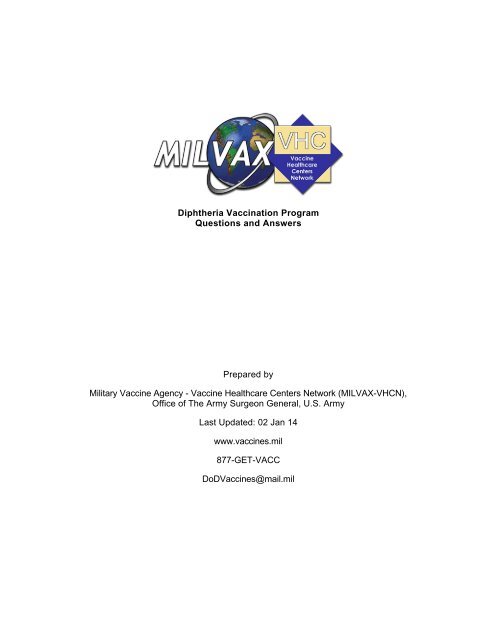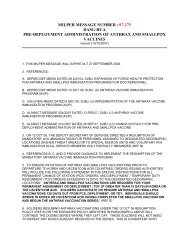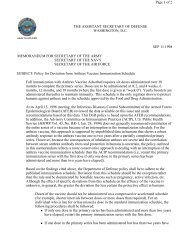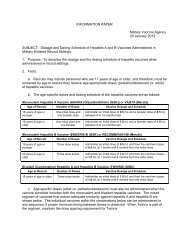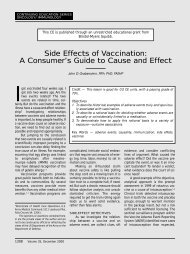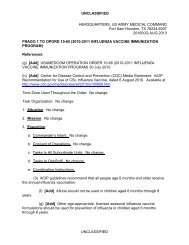Prepared by - MILVAX
Prepared by - MILVAX
Prepared by - MILVAX
Create successful ePaper yourself
Turn your PDF publications into a flip-book with our unique Google optimized e-Paper software.
Diphtheria Vaccination Program<br />
Questions and Answers<br />
<strong>Prepared</strong> <strong>by</strong><br />
Military Vaccine Agency - Vaccine Healthcare Centers Network (<strong>MILVAX</strong>-VHCN),<br />
Office of The Army Surgeon General, U.S. Army<br />
Last Updated: 02 Jan 14<br />
www.vaccines.mil<br />
877-GET-VACC<br />
DoDVaccines@mail.mil
Diphtheria Vaccination Program<br />
Questions and Answers<br />
The Disease<br />
A. Overview<br />
B. Symptoms<br />
C. Complications<br />
The Vaccine<br />
A. Overview<br />
B. Administration<br />
C. Contraindications<br />
Adapted from the Immunization Action Coalition (with permission) and the Centers for Disease Control and Prevention (CDC).<br />
www.vaccines.mil - Page 2 of 6 - 02 Jan 14
The Disease<br />
A.<br />
Overview<br />
1.<br />
How common is diphtheria in the United States<br />
2.<br />
3.<br />
4.<br />
Diphtheria was once the leading cause of death among children in the United States.<br />
Diphtheria was feared greatly. In the 1920s, 100,000-200,000 cases of diphtheria occurred<br />
each year resulting in 13,000-15,000 deaths. Diphtheria is now rare (fewer than five cases<br />
reported per year since 1980) thanks to improved living conditions and widespread<br />
immunization. However, recent surveys show that up to 60% of adults in the U.S. are not<br />
protected against diphtheria.<br />
Protection provided <strong>by</strong> childhood immunization decreases over time and many adults do not<br />
receive recommended booster doses (every 10 years). This is a concern because diphtheria<br />
the disease continues to occur in other parts of the world. From 1990 to 1998, more than<br />
150,000 cases and more than 5,000 deaths were reported in the former republics of the<br />
Soviet Union. This outbreak, and others around the world, illustrates what can happen when<br />
immunity levels fall. Outbreaks in other countries also increase the risk of diphtheria<br />
importation into the United States.<br />
What causes diphtheria<br />
Diphtheria is caused <strong>by</strong> a bacterium called Corynebacterium diphtheriae. The actual cause<br />
of disease is not the bacteria itself but a toxin, or poison, released into the body <strong>by</strong> the<br />
bacteria.<br />
How does diphtheria spread<br />
Diphtheria bacteria live in the mouth, throat, and nose of an infected person and can be<br />
passed to others <strong>by</strong> coughing or sneezing. Occasionally, transmission occurs from skin<br />
sores or through objects soiled with discharge from sores of infected persons.<br />
How long does it take to show signs of diphtheria after being exposed<br />
The incubation period is short: 2 to 5 days, with a range of 1 to 10 days.<br />
B.<br />
Symptoms<br />
1.<br />
2.<br />
What are the symptoms of diphtheria<br />
Early symptoms of diphtheria may mimic a cold with a sore throat, mild fever, and chills.<br />
Diphtheria often causes a thick coating at the back of the throat, which can make it difficult<br />
to breathe or swallow. The nose, eyes, skin, heart and kidneys are other body sites<br />
affected<br />
How serious is diphtheria<br />
Diphtheria is a serious disease: 5% to 10% of people with diphtheria die. Death occurs<br />
twice as often in those (older than 40 years or younger than 5 years).<br />
C.<br />
Complications<br />
www.vaccines.mil - Page 3 of 6 - 02 Jan 14
1.<br />
2.<br />
3.<br />
The Vaccine<br />
What are possible complications from diphtheria<br />
Most complications of diphtheria are due to diphtheria toxin. The toxin can cause swelling<br />
of the heart, leading to abnormal heart rhythms. It can also cause swelling of the nerves,<br />
which may cause temporary paralysis of some muscles. If the paralysis affects the<br />
diaphragm (the major muscle for breathing), the patient may develop pneumonia or<br />
respiratory failure. The thick membrane coating the back of the throat may cause serious<br />
breathing problems, even suffocation.<br />
How do I know if someone has diphtheria<br />
The diagnosis of diphtheria can only be confirmed <strong>by</strong> laboratory testing. However, treatment<br />
is usually begun based on clinical suspicion, because early treatment improves the<br />
likelihood that a person recovers.<br />
How long is a person with diphtheria contagious<br />
About 48 hours after antibiotics are started, a person is no longer contagious. However,<br />
some individuals continue to carry diphtheria bacteria even after antibiotic therapy. This is<br />
called the carrier state. Carriers should continue treatment until three consecutive<br />
laboratory tests for diphtheria are negative. People caring for a patient with diphtheria<br />
should take standard contact precautions and ensure their diphtheria immunization is<br />
up-to-date.<br />
A.<br />
Overview<br />
1.<br />
2.<br />
Is there a treatment for diphtheria<br />
Diphtheria is treated with both antibiotics and with diphtheria antitoxin. Antitoxin is the<br />
name for antibodies that neutralize toxins. Diphtheria antitoxin is produced in horses and<br />
was first used in the United States in 1891. Antitoxin is not effective against toxin that is<br />
already attached to the body's tissues, but antitoxin will neutralize circulating poison and<br />
prevent the disease from getting worse. The patient should be tested for antitoxin sensitivity<br />
(because it is horse-derived) before administration.<br />
What kind of vaccine prevents diphtheria<br />
The diphtheria vaccine consists of a modified toxin called a toxoid. The vaccine is made <strong>by</strong><br />
growing the bacteria in a liquid medium and purifying and inactivating the toxin.<br />
3.<br />
When did the diphtheria vaccine become available<br />
The first toxoid against diphtheria was developed around 1921, but was not widely used<br />
until the 1930’s. In the 1940’s, diphtheria was combined with pertussis vaccine and tetanus<br />
toxoid to make the combination DTP (or DTaP) vaccine for children.<br />
Diphtheria toxoid (DT) is also combined in other vaccines:<br />
DT vaccine for the few children who cannot receive pertussis vaccine.<br />
Td vaccine for people 7 years or older (tetanus toxoid and a reduced dose of diphtheria<br />
toxoid).<br />
www.vaccines.mil - Page 4 of 6 - 02 Jan 14
4.<br />
5.<br />
6.<br />
7.<br />
8.<br />
9.<br />
Tdap vaccine for people 10 years or older (tetanus toxoid with reduced doses of<br />
diphtheria toxoid and acellular pertussis vaccine).<br />
Diphtheria toxoid is not available as a single vaccine.<br />
Who recommends this vaccine<br />
The Centers for Disease Control and Prevention (CDC), the American Academy of<br />
Pediatrics (AAP), and the American Academy of Family Physicians (AAFP) all recommend<br />
this vaccine.<br />
How safe is this vaccine<br />
Serious reactions after immunization are rare. The most common reactions are soreness,<br />
redness, and swelling at the injection site. Other possible reactions may include fussiness,<br />
mild fever, loss of appetite, tiredness, and vomiting. The use of the more purified DTaP<br />
vaccine, instead of DTP has decreased even these mild reactions.<br />
Can the vaccine cause diphtheria<br />
No.<br />
Do I need to be immunized if I had diphtheria<br />
Yes. Unfortunately, some people who suffer diphtheria illness do not produce enough<br />
antitoxin to prevent future illness. It is recommended that people recovering from diphtheria<br />
be immunized.<br />
What's the difference between DT and Td vaccines<br />
The difference is the amount of diphtheria toxoid contained in each dose. Pediatric DT ("big<br />
D") contains 3 to 5 times more diphtheria toxoid than the adult Td ("little d"). DT is used for<br />
the few children who cannot receive the pertussis component of the DTaP vaccine, and Td<br />
is used for adults and children seven years of age and older who need booster doses of<br />
diphtheria and tetanus toxoid.<br />
Should adults who weren't immunized as children receive this vaccine as adults<br />
Yes. Adults or children seven years and older without documentation of tetanus and<br />
diphtheria vaccination should receive a primary series of three doses of Tetanus-diphtheria<br />
toxoid (Td). The first two doses should be separated <strong>by</strong> 4 to 8 weeks, and the third dose<br />
given 6 to 12 months after the second dose. Td will protect you from diphtheria infection as<br />
well as tetanus.<br />
B.<br />
Administration<br />
1.<br />
How is the vaccine given<br />
The vaccine is given as a single injection into the muscle (IM). The usual schedule for<br />
infants is a series of four doses given at two, four, six, and 15 to 18 months of age. A fifth<br />
shot, or booster dose, is recommended at 4 to 6 years of age, unless the fourth dose was<br />
given late (after the fourth birthday). Because immunity to diphtheria and pertussis wanes<br />
with time, adolescents (11 to 18 years old) should receive a booster dose of Tdap and later<br />
booster doses of Td (adult tetanus and diphtheria) every ten years.<br />
www.vaccines.mil - Page 5 of 6 - 02 Jan 14
2.<br />
3.<br />
I received Tdap a few days ago. Now my arm is red and swollen down to the<br />
elbow. What should I do<br />
The redness and swelling may be an adverse event caused <strong>by</strong> your Tdap immunization.<br />
Contact your healthcare provider or the <strong>MILVAX</strong>-VHCN. We can help you to get treatment<br />
and help you file a Vaccine Adverse Event Report.<br />
My child has a large lump where the DTaP shot was given. Should I take her to our<br />
pediatrician<br />
DTaP vaccination may cause side effects, such as swelling, redness, pain, and/or warmth<br />
where the shot was given. These side effects may last for 1 to 2 days, and usually go away<br />
on their own. If you have more questions, contact a <strong>MILVAX</strong>-VHCN healthcare provider and<br />
send us a photo of the reaction using our Ask VHC secure messaging.<br />
C.<br />
Contraindications<br />
1.<br />
Who should NOT receive diphtheria vaccine<br />
People who have had a serious allergic reaction to a dose of vaccine containing diphtheria<br />
toxoid should not receive another vaccination. Persons with a moderate or severe illness<br />
should postpone receiving the vaccine until their condition has improved.<br />
www.vaccines.mil - Page 6 of 6 - 02 Jan 14


